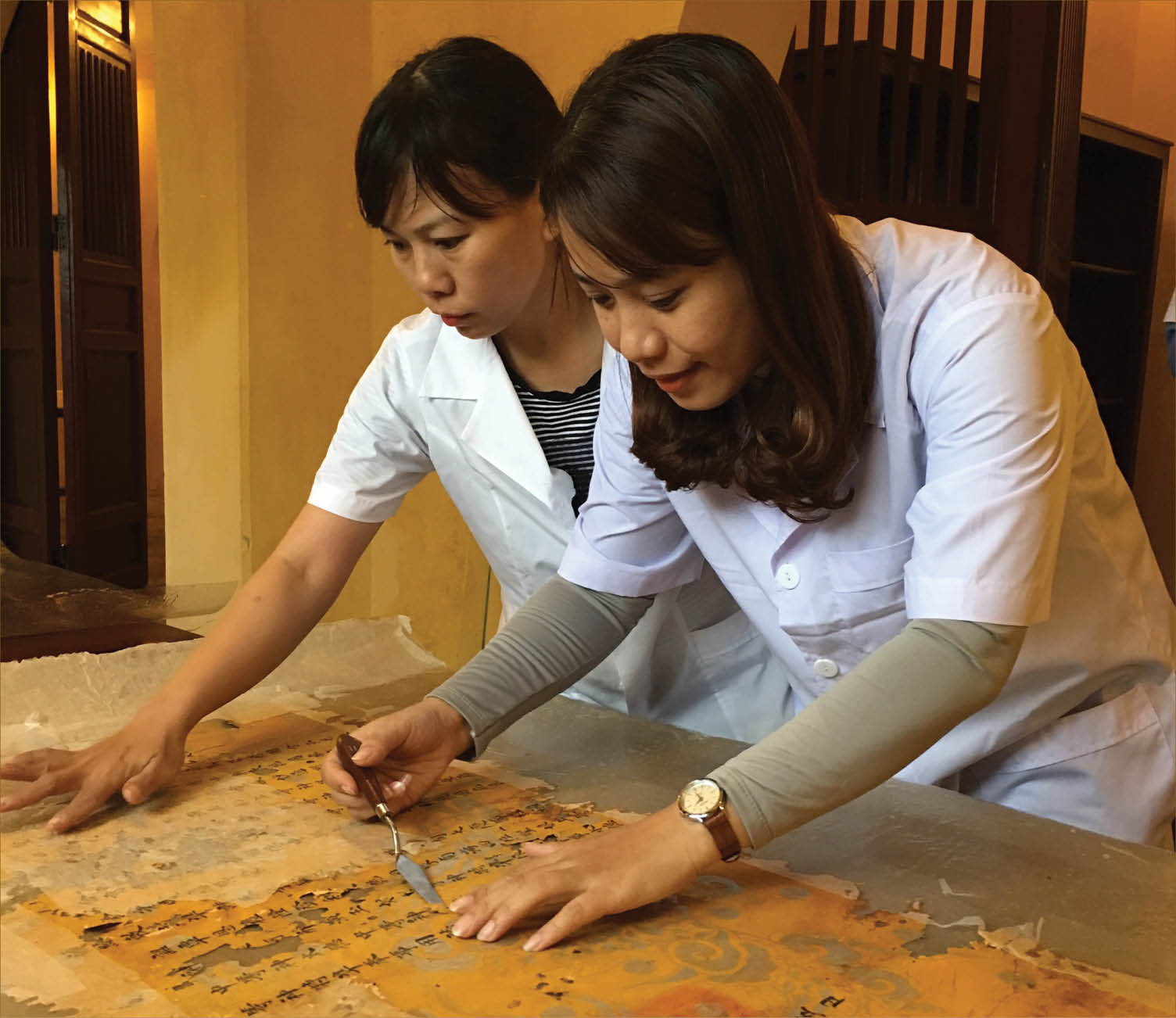
Processing sac phong. Photo: The research group
On the first floor of Lau Tang Tho (Royal Archives) (Dinh Tien Hoang Str., Hue City), for many months now, people in the Scientific Research Department of Hue Monuments Conservation Center have been diligently working to process, restore and preserve sac phong documents. Unlike what people often think, that this work is merely suitable for the elderly with thick glasses on their faces who study Sino-Vietnamese, people here are all young and active. Seeing their happiness after a sac phong is restored, we figure out they are like inspiring hyphens between the present and the past.
Sac phong is a type of royal high-ranking administrative document in Sino-Vietnamese, issued and granted by the emperor to people who are honored, rewarded, promoted, entitled, etc. It was great honor for clans and villages to be given sac phong.
Original, unique and scarce, sac phong is considered an important source of texts for culture and history research. Sac phong granted to an individual contains his name, position, title and status.
The fact that the deity was also honored, worshiped or rewarded with beautiful names demonstrated their important role and status to the country and villages. Over time, together with the Sino-Vietnamese heritage, many sac phong have been lost or ruined, badly influencing the process of researching and promoting the unique values which this source of documents brings.
At present, not many places actively process and revive sac phong written on giay do (a special kind of paper) for their protection. The National Archives in Hanoi and the General Library in Ho Chi Minh City have implemented this task but only with on-site resources. Meanwhile, Hue Monuments Conservation Center has not only restored and preserved on-site documents, but also assisted villages and clans with the restoration of their badly ruined sac phong.
The journey of restoring sac phong which are damp, moldy and falling to pieces are days when people at the Scientific Research Department concentrated on sticking giay do on them. All steps are done entirely by hand, from separating, mold treating, to connecting characters and sticking giay do on the documents.
Restored sac phong, if preserved properly, can last a very long time, thanks to the fact that giay do can bear hot and humid weather. This paper was made manually and was bought from Japan or traditional villages in Ha Noi.
The powder for the glue is special too, assisted by Sino-Vietnamese Institution. Technicians who do this kind of work are those who are patient, careful and can work with care and know much about Sino-Vietnamese. The technician Nguyen Hoang Khanh Trang was reading a sac phong, granted in the 5th year of Emperor Thieu Tri’s Era, saying: There must be always an expert in Sino-Vietnamese nearby. Some sac phong are decaying and separated into two or three pieces. If one does not know Sino-Vietnamese, possibly one will make mistakes when combining the pieces together.
At the Royal Archives, Dr. Le Thi An Hoa (Head of the Scientific Research Department) and her colleagues showed us sac phong being rescued. But behind their joy is a very pitiful story.
According to Dr. An Hoa, these sac phong all belong to a village in Huong Tra town. In 2014-2016, when we accessed them to collect and digitize Sino-Vietnamese documents, they were still in good conditions. But at the end of the year, we met the villagers at Hue Monuments Conservation Center, asking about how to rescue sac phong.
Sac phong have been existing in good condition for nearly one hundred years, but because they have not been preserved properly, they were ruined badly in just some years. Some of them got stuck and were being decomposed.
Before that, after all sac phong had been digitized, there appeared a rumor that there were thieves who wanted to steal sac phong. Worried, some people rolled sac phong and wrapped them in plastic bags, then put them in an aluminum box and hid the box in a cement cabinet. In that way, people unconsciously made sac phong humid and ruined them even faster.
According to Dr. Le Thi An Hoa, every time Hue Monuments Conservation Center can access the source of sac phong documents kept by villages and clans, they show villagers the way to preserve them to ensure their longevity. The best way, according to traditional experience, is to roll sac phong and put it in a bamboo tube together with some dried peppercorns and store it in dry places and always keep an eye on it.
The luck of the village mentioned above is that all sac phong possessed by the village had been digitized and conserved. Other villages which boast this heritage should learn the lesson from it.
Story: DONG VAN